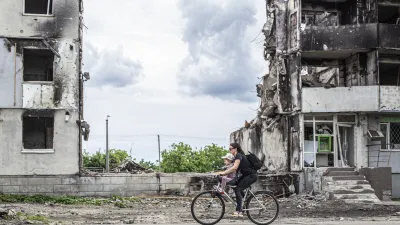In a speech Thursday, Mayor Bloomberg laid out his strategy for rebuilding a stronger, smarter New York in anticipation of future natural disasters.
In a speech that was short on specifics but frank in acknowledging the future challenges from the effects of global warming, Bloomberg laid out a multipronged approach to recovering from Superstorm Sandy while preparing for the next disaster. He touched on plans to expand the city's evacuation zones, "revise building codes and look for ways to better protect critical infrastructure like transportation and electrical networks," reports Michael M. Grynbaum.
While dismissing the case for "expensive experiments like sea gates," the mayor "said the city would consider the construction of dunes, jetties, levees and berms along coastal areas to help reduce damage from future storm surges. Height restrictions on some residential homes will be relaxed so owners can elevate their houses above the flood plain, and the city will update its building code to require more stringent protection against floods."
"The city will also update its flood maps and extend the so-called Zone A evacuation area to include Howard Beach, Queens, and the Brooklyn neighborhoods of Gerritsen Beach and East Williamsburg, communities that were heavily and unexpectedly damaged by flooding from Hurricane Sandy," notes Grynbaum.
“Let me be clear,” Mr. Bloomberg said. “We are not going to abandon the waterfront. We are not going to leave the Rockaways or Coney Island or Staten Island’s South Shore.”
“But we cannot just rebuild what was there and hope for the best,” he added. “We have to build smarter and stronger and more sustainable.” The city has convened a working group “to determine exactly what that means,” he said.
FULL STORY: Mayor Announces Plans to Protect City From Natural Disasters

Study: Maui’s Plan to Convert Vacation Rentals to Long-Term Housing Could Cause Nearly $1 Billion Economic Loss
The plan would reduce visitor accommodation by 25% resulting in 1,900 jobs lost.

Alabama: Trump Terminates Settlements for Black Communities Harmed By Raw Sewage
Trump deemed the landmark civil rights agreement “illegal DEI and environmental justice policy.”

Why Should We Subsidize Public Transportation?
Many public transit agencies face financial stress due to rising costs, declining fare revenue, and declining subsidies. Transit advocates must provide a strong business case for increasing public transit funding.

Paris Bike Boom Leads to Steep Drop in Air Pollution
The French city’s air quality has improved dramatically in the past 20 years, coinciding with a growth in cycling.

Why Housing Costs More to Build in California Than in Texas
Hard costs like labor and materials combined with ‘soft’ costs such as permitting make building in the San Francisco Bay Area almost three times as costly as in Texas cities.

San Diego County Sees a Rise in Urban Coyotes
San Diego County experiences a rise in urban coyotes, as sightings become prevalent throughout its urban neighbourhoods and surrounding areas.
Urban Design for Planners 1: Software Tools
This six-course series explores essential urban design concepts using open source software and equips planners with the tools they need to participate fully in the urban design process.
Planning for Universal Design
Learn the tools for implementing Universal Design in planning regulations.
Smith Gee Studio
Alamo Area Metropolitan Planning Organization
City of Santa Clarita
Institute for Housing and Urban Development Studies (IHS)
City of Grandview
Harvard GSD Executive Education
Toledo-Lucas County Plan Commissions
Salt Lake City
NYU Wagner Graduate School of Public Service



























